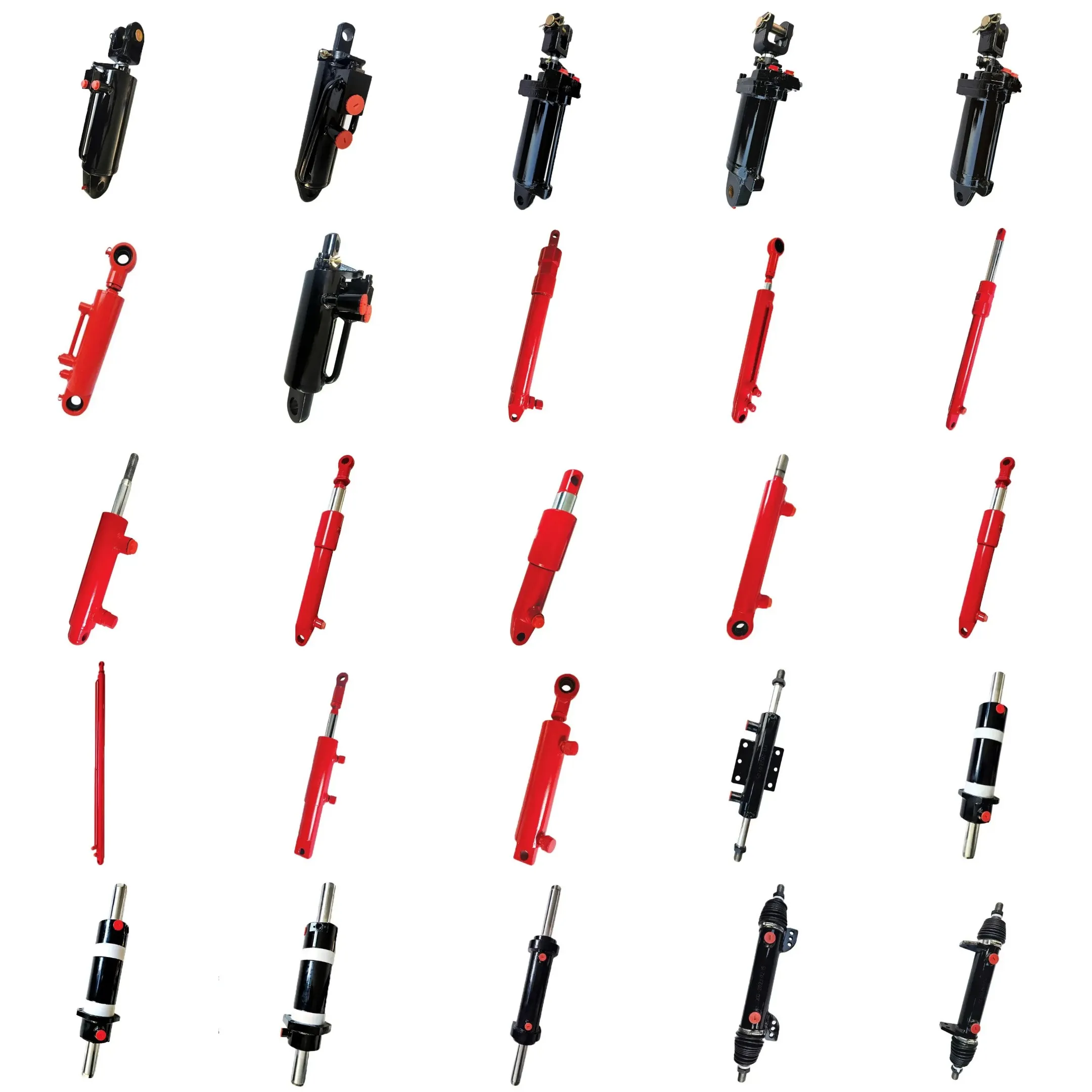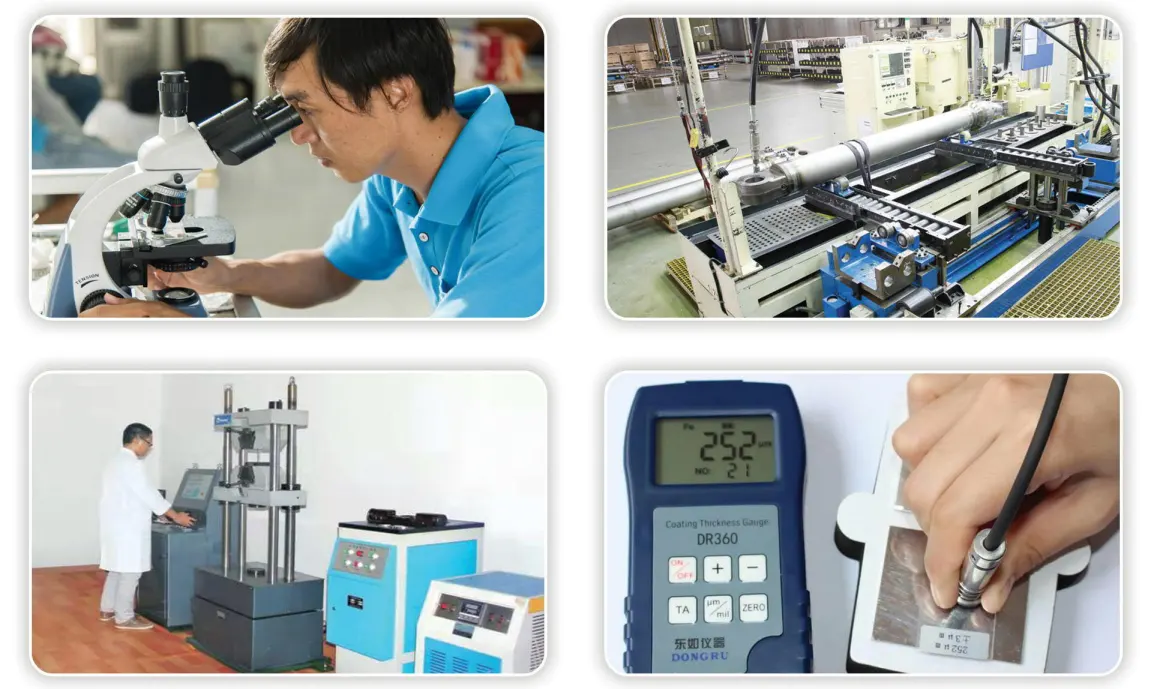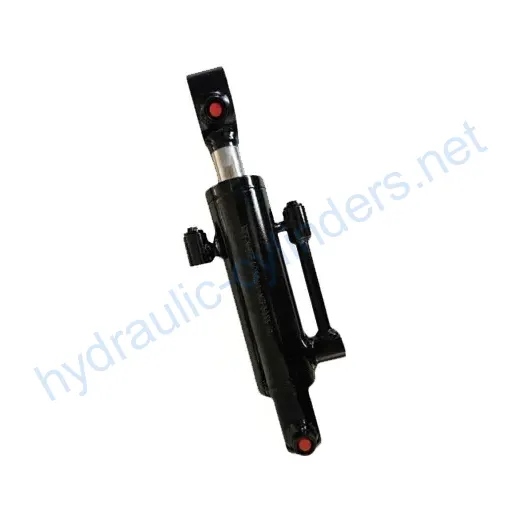CSYG2077 Micro Digging Bulldozer Hydraulic Cylinder
CSYG2077 Micro Digging Bulldozer Hydraulic Cylinder
Product Introduction
The CSYG2077 Micro Digging Bulldozer Hydraulic Cylinder is a high-performance component designed for heavy machinery in construction and excavation. This hydraulic cylinder is crucial for converting hydraulic energy into mechanical motion, enabling machines to perform various tasks, such as lifting, pushing, and digging with efficiency and precision. With its robust construction and advanced engineering, it provides reliable operation in demanding environments. The hydraulic cylinder plays an essential role in ensuring that the bulldozer operates smoothly, allowing for improved productivity and reduced downtime. Its performance is characterized by a combination of strength, durability, and operational efficiency, making it an indispensable part of micro digging bulldozers.
Product Specifications
- Cylinder Diameter: 50mm
- Rod Diameter: 3mm
- Travel: 75mm
- Installation Distance: 315mm
Parameter Expansion
The specifications of the CSYG2077 hydraulic cylinder reflect its design for specific applications. The cylinder diameter of 50mm indicates its strength, capable of handling substantial loads during operation. The rod diameter of 3mm provides a balance between strength and weight, ensuring efficient movement while maintaining durability. With a travel distance of 75mm, this cylinder can deliver precise control and movement, essential for tasks requiring high accuracy. An installation distance of 315mm ensures compatibility with various machinery setups, allowing for easy installation and integration into existing systems.
Product Features
- High Efficiency: Engineered for optimal performance, ensuring minimal energy loss during operation.
- Robust Design: Built to withstand heavy loads and harsh conditions, offering long-lasting reliability.
- Compact Size: Ideal for micro digging applications where space is limited without compromising strength.
- Easy Installation: Designed for straightforward integration into various equipment.
- Custom Manufacturing: Ability to produce tailored solutions to meet specific customer needs.
Application Scenarios
Construction Sites
The CSYG2077 hydraulic cylinder is extensively used in construction sites where micro excavation is required. The cylinder??s compact size allows for precise digging in confined areas, making it ideal for trenches, foundations, and other construction tasks. Its strength ensures that it can handle the forces generated during excavation, contributing to effective project completion. Additionally, its reliability minimizes downtime, which is critical in construction operations where schedules are tight. The ability to perform intricate tasks efficiently enhances overall productivity on-site.
Landscaping Projects
In landscaping, the CSYG2077 hydraulic cylinder plays a pivotal role in enabling precise movement for tasks such as planting, grading, and installing features like ponds or retaining walls. The cylinder’s accurate control allows operators to create detailed landscapes with minimal soil disruption. Its durability means it can endure the rigors of outdoor work, making it a preferred choice for landscaping professionals. Furthermore, the efficiency of the hydraulic system helps in reducing operational costs, allowing for more competitive pricing on landscaping services.
Mining Operations
In mining operations, particularly in small-scale or micro-mining projects, the CSYG2077 hydraulic cylinder is crucial for tasks such as digging and lifting materials. Its robust design ensures that it can handle the harsh conditions often found in mining environments, providing operators with the confidence that it will perform reliably. The cylinder’s ability to operate efficiently under significant load conditions enhances productivity, making it a valuable asset in any mining operation. The versatility of this hydraulic cylinder allows it to adapt to various mining machinery, further extending its usability.
Forestry and Agricultural Machinery
In forestry and agriculture, the CSYG2077 hydraulic cylinder is utilized in equipment like compact tractors and tree harvesters. Its compact nature allows it to fit into smaller machines while delivering the necessary power to perform tasks like lifting and moving heavy loads. The reliability of the hydraulic cylinder contributes to smoother operations, whether it??s for clearing land, assisting in planting, or gathering resources. This versatility makes it an essential component for both agricultural and forestry applications.
Utility Work
Utility work often involves using specialized equipment for digging trenches for cables or pipelines. The CSYG2077 hydraulic cylinder’s precise control and compact design make it excellent for such tasks. It allows utility workers to perform their duties efficiently, ensuring minimal disruption to the surrounding area. Moreover, the cylinder??s durability ensures that it can withstand the challenges of utility work, providing long-term reliability and performance essential for maintaining service integrity in public infrastructure.
Design Considerations and Selection Criteria
Load Capacity
When selecting a hydraulic cylinder like the CSYG2077, one of the primary considerations is its load capacity. This refers to the maximum weight the cylinder can lift or move safely without failure. Designing for adequate load capacity involves using high-strength materials and ensuring that the cylinder’s components are engineered to handle expected load forces. Manufacturers must test their products under various conditions to guarantee reliability, as underestimating load capacity can lead to catastrophic failure during operation. A well-designed hydraulic cylinder will have a safety factor incorporated into its design, ensuring it can handle loads exceeding its rated capacity without risk of failure.
Sealing Mechanisms
Sealing mechanisms within a hydraulic cylinder are critical for maintaining pressure and preventing fluid leakage. The design must include high-quality seals, such as piston seals and rod seals, that can withstand extreme pressures and environmental conditions. Common materials for these seals include polyurethane and nitrile rubber, chosen for their durability and resistance to wear. Proper sealing ensures the hydraulic system operates efficiently, as any leakage can lead to significant performance issues and increased maintenance costs. Regular inspections of the sealing components are necessary to ensure they remain effective, as worn seals can compromise the entire hydraulic system.
Durability
Durability is a key attribute of any hydraulic cylinder. The CSYG2077 is designed to endure harsh operating conditions, which is essential for its application in demanding environments. Material selection plays a significant role in durability, as components must resist wear, corrosion, and fatigue over time. Advanced manufacturing techniques, including surface treatments and coatings, can enhance the durability of hydraulic cylinders. Regular maintenance and inspections can further prolong the lifespan of the hydraulic cylinder, ensuring it continues to perform optimally without unexpected failures.
Safety Features
Safety is paramount when designing hydraulic cylinders. The CSYG2077 incorporates features that enhance operational safety, such as pressure relief valves and robust construction to withstand unexpected loads. Operators must be educated on the safe operation of the hydraulic system, including understanding the limitations of the equipment. Regular safety audits and training sessions can help identify potential risks and mitigate them, ensuring a safer working environment. Implementing these safety features not only protects the operator but also enhances the overall reliability of the hydraulic system.
Maintenance and Serviceability
Design considerations must also include maintenance and serviceability. A hydraulics cylinder, like the CSYG2077, should be easy to service for repairs or replacements. Accessibility to key components is important for efficient maintenance routines, which can significantly reduce downtime. Additionally, manufacturers should provide clear guidelines for maintenance schedules, ensuring that operators are aware of when to perform routine checks. Well-designed hydraulic cylinders will have features that facilitate easy disassembly and reassembly, enabling quick repairs and minimizing operational disruptions.
Sealing and Lubrication
Effective sealing and lubrication are essential for the optimal performance of hydraulic cylinders. Various sealing components, including piston seals and rod seals, are critical to maintaining hydraulic pressure and preventing leaks. Seals made from high-quality materials such as polyurethane and nitrile rubber provide resistance to wear and environmental factors, ensuring longevity. The cylinder body and threaded end surfaces undergo precision treatment to enhance wear resistance, contributing to overall performance. Furthermore, regular lubrication with hydraulic oil is necessary to ensure smooth operation and prevent metal-on-metal contact that could lead to premature wear. Proper maintenance of seals and lubrication systems is crucial to maintaining the cylinder’s functionality and extending its service life.
Regular Inspection and Preventive Maintenance
Inspection Procedures
Regular inspections should be conducted on the hydraulic cylinder to identify any potential issues before they escalate. This includes checking for leaks, inspecting seals, and ensuring that there is no visible wear on critical components. Operators should be trained to conduct these inspections and document findings for proper follow-up. A systematic approach to inspections can prevent costly repairs and prolong the lifespan of the hydraulic cylinder.
Preventive Maintenance Measures
Implementing preventive maintenance measures can significantly reduce the risk of failure. This includes regularly scheduled lubrication to ensure that moving parts are well-oiled and functioning smoothly. Additionally, operators should routinely check and replace seals as necessary to prevent leaks and maintain pressure within the system. Keeping records of maintenance activities helps in tracking the performance and reliability of the hydraulic cylinders.
Replacing Worn Components
Replacing worn components is a crucial part of maintenance. When performing regular inspections, operators should be vigilant in identifying parts that show signs of wear or damage. Timely replacement of these components can prevent larger failures and ensure continued operation. It is advisable to keep a stock of commonly replaced parts on hand to minimize downtime. Providing training for technicians on recognizing wear indicators can enhance the overall reliability of the hydraulic system.
Installation Guidelines
Proper installation of the CSYG2077 hydraulic cylinder is essential for optimal performance. Begin by ensuring that the working environment is clean and free of debris. Align the cylinder accurately with the mounting brackets to prevent undue stress on the seals and rod. It is crucial to use appropriate mounting supports to secure the cylinder in place and avoid misalignment. After installation, inspect the connections to ensure they are tight and leak-free. Once installed, fill the hydraulic system with the recommended hydraulic fluid and bleed the system to remove any air pockets. Testing the cylinder’s operation before it goes into full service is also vital to ensure everything functions correctly.
Common Maintenance Tasks
Regular Checks
Conducting regular checks is vital in maintaining the hydraulic cylinder??s integrity. Operators should routinely inspect the cylinder for leaks, ensuring that no hydraulic fluid is escaping that could compromise performance. This involves checking both the external surfaces and the seals to identify any potential failures early. Regular checks not only help in maintaining the system but also ensure safety by preventing unexpected malfunctions during operation.
Proper Lubrication
Proper lubrication is essential for the functionality of the hydraulic cylinder. Operators should ensure that the cylinder is filled with the appropriate hydraulic oil and that the lubrication points are adequately serviced. Regular lubrication minimizes wear on moving parts and enhances the overall efficiency of the hydraulic system. Operators must be trained to understand the correct lubrication intervals and to recognize when additional lubrication is necessary based on operational conditions.
Seal Replacement and Calibration Checks
Seal replacement is a common maintenance task that ensures the hydraulic system remains leak-free. Operators should be on the lookout for any signs of wear on seals and replace them as needed to maintain optimal pressure within the system. Calibration checks are also essential to ensure the cylinder is operating within its intended parameters. This involves testing the cylinder??s performance to confirm that it meets specified load and travel requirements. Maintenance personnel should be familiar with the replacement procedures for seals and calibration processes to ensure efficient operation.
Safety Considerations and Environmental Factors
Safety measures are critical when working with hydraulic systems. Operators must be trained to recognize potential hazards associated with hydraulic cylinders, including high-pressure risks and the importance of proper handling during installation and maintenance. Ensuring that safety guards and barriers are in place can prevent accidents during operation. Additionally, environmental factors such as temperature and humidity can affect hydraulic fluid performance, so it is crucial to monitor these conditions to maintain system efficiency. Proper disposal of hydraulic fluids and worn components should also be considered to minimize environmental impact.
Troubleshooting and Common Issues
Leakage Problems
Leakage is one of the most common issues encountered with hydraulic cylinders. It can occur due to worn seals, damaged threads, or improperly installed components. When faced with leakage, operators should first identify the source of the leak and replace any worn seals immediately. Ensuring that the cylinder is correctly aligned during installation can also prevent future leaks caused by misalignment.
Reduced Performance
Reduced performance can manifest as slower operating speeds or diminished lifting capacity. This may be due to insufficient hydraulic fluid levels, air trapped in the system, or blockages in the hydraulic lines. Operators should check fluid levels, bleed the system of any trapped air, and inspect all lines for blockages to diagnose and rectify performance issues.
Abnormal Noises
Abnormal noises during operation, such as grinding or hissing, can indicate underlying issues. Grinding noises may suggest mechanical wear, while hissing noises often point to leaking seals. It is essential to conduct a thorough inspection of the cylinder and surrounding components when abnormal noises occur, addressing any issues immediately to prevent further damage.
Troubleshooting Tips and Solutions
To effectively troubleshoot issues with the CSYG2077 hydraulic cylinder, operators should follow specific guidelines. First, regular inspections should be prioritized to catch potential problems early. Keeping detailed logs of maintenance activities can help identify recurring issues and inform better decision-making. If a problem arises, systematic troubleshooting should be undertaken, starting from the simplest solutions, such as checking fluid levels and seals, before moving on to more complex diagnostics. Operators should also be educated on best practices to prevent issues from occurring, such as adhering to maintenance schedules and using the correct hydraulic fluids.

About Our Company
We are a leading manufacturer of hydraulic cylinders, offering a wide range of products that cater to various industrial needs. Our commitment to quality has positioned us as one of the top hydraulic cylinder manufacturers and wholesalers in both domestic and international markets. We prioritize professionalism, ensuring that all our products meet stringent international certifications. Our state-of-the-art production equipment enables us to manufacture cylinders that are not only high-performing but also customizable to meet unique customer demands. Coupled with excellent after-sales service, we guarantee customer satisfaction and support throughout the product lifecycle.

Author: lyl

参观我们的 VR 工厂
通过以下方式参观我们的 VR 工厂
液压缸应用:


